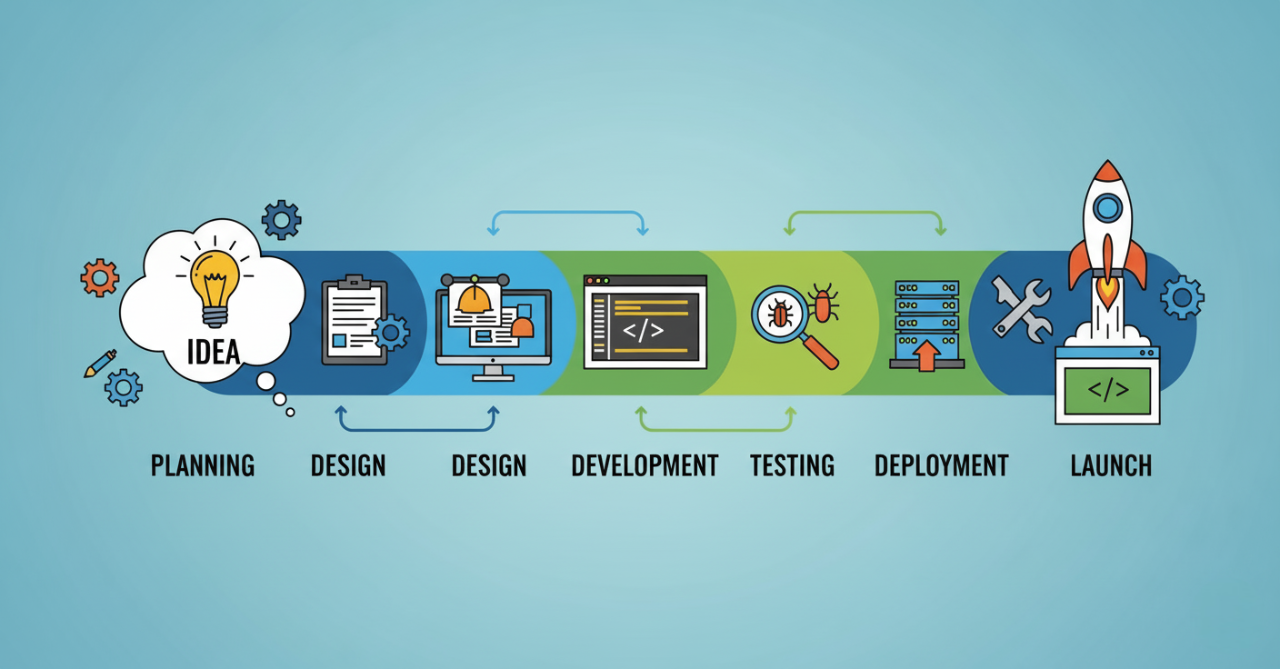From Idea to Launch: My Step-by-Step Approach to Building Web Solutions

Introduction
For many clients, the journey from having a business idea to seeing a fully functional website or web application feels overwhelming. They know what they want to achieve but not how to get there. That’s where a structured, transparent process makes all the difference.
Over the past 3 years as a full-stack developer, I’ve helped businesses and startups transform their raw ideas into live, scalable solutions. And while every project is unique, the approach I follow stays consistent - ensuring clarity, speed, and measurable results.
In this blog, I’ll share my step-by-step process of building web solutions, highlighting not just the technical work but also the problem-solving mindset that clients value the most.
The Problem: Why Projects Often Fail Without a Clear Process
Before we dive into the steps, let’s acknowledge the issues many businesses face:
- Unclear Requirements: Businesses start development without clarity, leading to scope creep and budget overruns.
- Poor Communication: Clients are often left in the dark about progress or decisions.
- Over-Engineering: Developers sometimes build overly complex systems instead of focusing on the client’s immediate needs.
- Delayed Launches: Without a structured roadmap, projects drag on for months, losing market opportunities.
Having a process avoids these pitfalls and keeps projects focused on solving the client’s business problem.
The Approach: A Step-by-Step Framework
I treat web development as a collaborative journey with the client. My framework is designed to reduce risks, ensure transparency, and get to launch efficiently.
Here’s how I do it:
Step 1: Discovery & Understanding the Problem
The first step isn’t about code - it’s about listening.
- I start with a deep dive into the client’s business idea: What problem are they solving? Who is the target audience? What are their goals?
- I also analyze competitors and industry trends to ensure the solution stands out.
Example: A startup approached me with the idea of a food delivery platform. Instead of jumping into development, I first mapped their target users (busy professionals, students) and studied competitors. This revealed that speed of delivery and local vendor partnerships should be their differentiator.
Step 2: Planning & Wireframing
Once the idea is clear, we translate it into structure.
- Create wireframes (blueprints of the application/website).
- Define user journeys - how will customers interact with the solution?
- Prioritize features (what’s needed for launch vs. what can come later).
This helps clients visualize their idea before any code is written.
Step 3: Building the MVP (Minimum Viable Product)
Instead of trying to build everything at once, I focus on creating a lean version that delivers core value.
- Core functionality comes first.
- Scalable architecture ensures future growth.
- Lightweight design prioritizes usability over polish in the MVP stage.
Example: For the food delivery project, the MVP only included order placement, vendor listing, and basic delivery tracking. Payment integrations and loyalty programs came later. This allowed the business to launch faster and test the market.
Step 4: Iterative Development & Feedback Loops
I follow an agile approach where we build in short sprints and review progress often.
- Clients see live demos after every milestone.
- Feedback is incorporated immediately to avoid rework.
- Transparency builds trust - clients always know where the project stands.
Step 5: Testing & Quality Assurance
Before launch, I thoroughly test the solution across:
- Functionality: Does everything work as expected?
- Speed: Is the website/app fast and responsive?
- Cross-device compatibility: Mobile, tablet, desktop.
- Security: Especially important for handling sensitive data.
This stage ensures a smooth experience for end users.
Step 6: Deployment & Launch
The launch stage is not just about pushing code live.
- I ensure server setup, domain configuration, and SSL are ready.
- Implement analytics to track performance.
- Train the client’s team (if needed) to manage content or operations.
The result is a seamless launch where the business can confidently start onboarding users.
Step 7: Post-Launch Support & Scaling
The journey doesn’t end at launch.
- I provide ongoing maintenance to fix issues or make improvements.
- Analyze user behavior to identify new opportunities.
- Scale features as the business grows.
Example: The food delivery platform initially launched in one city. After validating the idea, we scaled it to multiple cities with advanced features like real-time driver tracking and customer loyalty rewards.

The Result: Benefits of a Structured Development Approach
Clients who follow this process experience:
- Clarity from Day 1: No surprises about scope or costs.
- Faster Time to Market: Launching an MVP early means testing ideas faster.
- Better ROI: Resources are spent on features that matter.
- Ongoing Growth: The solution adapts and scales with business needs.
Final Thoughts
Building web solutions is more than writing code - it’s about solving business problems. A clear, step-by-step process ensures clients don’t just get a website or app, but a growth tool that drives results.
This structured approach has worked across industries, whether for startups launching MVPs or small businesses modernizing their online presence.
Call to Action
Do you have an idea you’re ready to bring to life? Let’s turn it into a working solution. From discovery to launch, I guide you through every step - ensuring speed, clarity, and results.
Contact me today to discuss your project and start building your next web solution.
